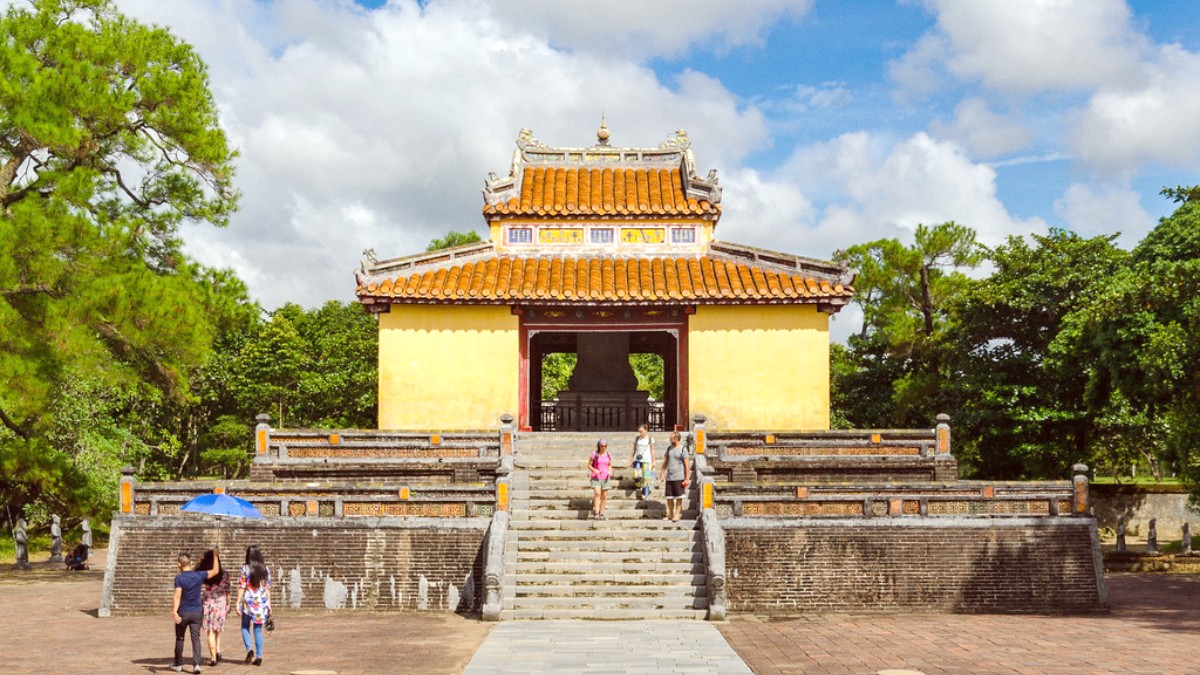
Central Vietnam, Vietnam
History blends with daily life here, presenting visitors an unique and memorable journey. Explore magnificent tombs, savor unique cuisine, and witness traditions that have shaped a nation.
Hue's past holds imperial grandeur and profound historical events. For 143 years, from 1802 to 1945, Hue served as the imperial capital of Vietnam under the Nguyen Dynasty, Vietnam's last feudal ruling family. During this period, Hue became the country's political, economic, and cultural core.
The city's collection of historical sites earned UNESCO World Heritage status in 1993, highlighting the universal value of its Imperial City, royal tombs, pagodas, and temples. These structures offer a tangible link to Vietnam's imperial past, demonstrating sophisticated architecture, landscaping, and spiritual practices. Walking through the Imperial City or exploring the elaborate tombs gives you a direct connection to the lives and legacies of the Nguyen emperors. Despite extensive damage during the Tet Offensive in 1968, restoration efforts continue, reflecting the city's enduring spirit and commitment to its heritage.
As of a 2022 estimate, the city proper has approximately 473,000 residents. Vietnamese is the official language. While a language barrier may appear in some local interactions, English is widely spoken in tourist areas. Hotels, larger restaurants, and tour operators include English-speaking staff. Learning a few basic Vietnamese phrases (like "hello" or "thank you") finds local appreciation.
Tourism is a major industry in Hue. The city's UNESCO sites attract visitors from around the world, supporting hotels, restaurants, local guides, and craft shops. Education also plays a role, with Hue University as a prominent institution. Traditional crafts, like conical hat making, embroidery, and lacquerware, continue to thrive, preserving ancient skills and unique souvenirs. Agriculture remains important in the surrounding plains, contributing fresh local produce to Hue's markets and cuisine.
Hue operates on Indochina Time (ICT), UTC+7. This places it 7 hours ahead of Coordinated Universal Time.
"Xin chào" (Hello), "Cảm ơn" (Thank you), "Bao nhiêu tiền?" (How much?), "Không sao" (No problem).
Vietnamese Dong (VND). USD is often accepted in tourist areas.
Wi-Fi is widespread in hotels and cafes. Local SIM cards are affordable and easy to obtain.
Look for tourist information centers in the city center for maps and local guidance.
This snapshot paints a picture of Hue as a city steeped in history, welcoming to visitors, and rooted in its local culture and traditions. The combination of its imperial heritage, the serene Perfume River, and the warm hospitality of its residents creates a compelling destination for travelers seeking a deep dive into Vietnamese culture.
Explore the remnants of the Nguyen Dynasty's grandeur, from the walled Imperial City to the intricate design of the royal tombs scattered along the Perfume River's banks. Each site tells an unique story of Vietnamese imperial life and power.
Beyond historical sites, Hue lives with markets, traditional craft villages, and a distinct culinary scene. Try the local specialties like Bún bò Huế, a spicy noodle soup, or the delicate imperial cuisine. Local customs and festivals add to the city's cultural richness.
Hue offers a journey back in time, while embracing the present. It remains a must-visit destination for those interested in Vietnam's imperial past and cultural landscape.
Prepare for your Hue adventure with careful consideration of the local climate, cultural norms, and practical travel needs. The right preparations ensure a comfortable and rewarding trip.
Hue experiences a tropical monsoon climate, with distinct wet and dry seasons. Awareness of these patterns guides packing and activity planning.
Higher temperatures, less rainfall. March-April are comfortable (25-30°C). May-August become hot and humid (above 35°C).
Heavy rainfall and cooler temperatures. September-November brings peak rain and potential flooding. December-February are cooler, damp, with light rain.
March to April are the most comfortable weather for extensive outdoor exploration.
Typhoon season (September-November) can bring strong winds and widespread flooding. Monitor weather forecasts if traveling during this time. Extreme temperatures in July and August can reach above 38°C (100°F); plan outdoor activities for early mornings or late afternoons during these months.
Citizens of some countries enter Vietnam without a visa for a specified duration (e.g., ASEAN countries, certain European nations, South Korea, Japan). The permitted stay length changes by nationality. Always check official Vietnamese government sources for current information.
Available for citizens of 80 countries. Apply online through the official Vietnam Immigration Department portal. A digital photo and scanned passport copy are necessary. Processing typically takes 3-5 working days. An e-visa is valid for 30 days and single entry. IVisa and VisaHQ support application processes.
A pre-approval letter from a licensed travel agency Before arrival in Vietnam is necessary. At an international airport, present this letter, passport, and photos, then pay a stamping fee. VOA works only for air travel, not land borders.
Vietnamese Dong (VND) is the official currency (1 USD ≈ 24,000 - 25,000 VND). ATMs are widely available, accepting international cards. Exchange major currencies at banks or authorized counters. Larger hotels and restaurants accept credit cards; smaller establishments prefer cash. Always carry smaller denominations.
Tipping is not a strong custom but finds appreciation. Round up bills or leave small amounts (10-15% for excellent service in upscale places). For tour guides and drivers, USD 5-10 per day is a generous gesture. Always agree on a price before services begin for cyclo rides or market purchases. For flight compensation, AirHelp assists with delayed or canceled flights.
Eat street food for delicious and affordable meals. Use Grab Bike for solo travel, often cheaper than Grab Car. Rent a bicycle for economical and enjoyable city exploration. Visit free attractions like Thien Mu Pagoda. Purchase large water bottles from supermarkets.